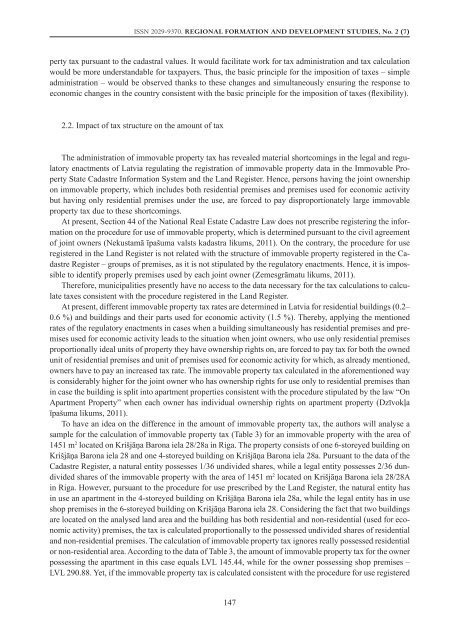regional formation and development studies - KlaipÄdos universitetas
regional formation and development studies - KlaipÄdos universitetas
regional formation and development studies - KlaipÄdos universitetas
You also want an ePaper? Increase the reach of your titles
YUMPU automatically turns print PDFs into web optimized ePapers that Google loves.
ISSN 2029-9370. Regional Formation <strong>and</strong> Development Studies, No. 2 (7)<br />
perty tax pursuant to the cadastral values. It would facilitate work for tax administration <strong>and</strong> tax calculation<br />
would be more underst<strong>and</strong>able for taxpayers. Thus, the basic principle for the imposition of taxes – simple<br />
administration – would be observed thanks to these changes <strong>and</strong> simultaneously ensuring the response to<br />
economic changes in the country consistent with the basic principle for the imposition of taxes (flexibility).<br />
2.2. Impact of tax structure on the amount of tax<br />
The administration of immovable property tax has revealed material shortcomings in the legal <strong>and</strong> regulatory<br />
enactments of Latvia regulating the registration of immovable property data in the Immovable Property<br />
State Cadastre In<strong>formation</strong> System <strong>and</strong> the L<strong>and</strong> Register. Hence, persons having the joint ownership<br />
on immovable property, which includes both residential premises <strong>and</strong> premises used for economic activity<br />
but having only residential premises under the use, are forced to pay disproportionately large immovable<br />
property tax due to these shortcomings.<br />
At present, Section 44 of the National Real Estate Cadastre Law does not prescribe registering the in<strong>formation</strong><br />
on the procedure for use of immovable property, which is determined pursuant to the civil agreement<br />
of joint owners (Nekustamā īpašuma valsts kadastra likums, 2011). On the contrary, the procedure for use<br />
registered in the L<strong>and</strong> Register is not related with the structure of immovable property registered in the Cadastre<br />
Register – groups of premises, as it is not stipulated by the regulatory enactments. Hence, it is impossible<br />
to identify properly premises used by each joint owner (Zemesgrāmatu likums, 2011).<br />
Therefore, municipalities presently have no access to the data necessary for the tax calculations to calculate<br />
taxes consistent with the procedure registered in the L<strong>and</strong> Register.<br />
At present, different immovable property tax rates are determined in Latvia for residential buildings (0.2–<br />
0.6 %) <strong>and</strong> buildings <strong>and</strong> their parts used for economic activity (1.5 %). Thereby, applying the mentioned<br />
rates of the regulatory enactments in cases when a building simultaneously has residential premises <strong>and</strong> premises<br />
used for economic activity leads to the situation when joint owners, who use only residential premises<br />
proportionally ideal units of property they have ownership rights on, are forced to pay tax for both the owned<br />
unit of residential premises <strong>and</strong> unit of premises used for economic activity for which, as already mentioned,<br />
owners have to pay an increased tax rate. The immovable property tax calculated in the aforementioned way<br />
is considerably higher for the joint owner who has ownership rights for use only to residential premises than<br />
in case the building is split into apartment properties consistent with the procedure stipulated by the law “On<br />
Apartment Property” when each owner has individual ownership rights on apartment property (Dzīvokļa<br />
īpašuma likums, 2011).<br />
To have an idea on the difference in the amount of immovable property tax, the authors will analyse a<br />
sample for the calculation of immovable property tax (Table 3) for an immovable property with the area of<br />
1451 m 2 located on Krišjāņa Barona iela 28/28a in Riga. The property consists of one 6-storeyed building on<br />
Krišjāņa Barona iela 28 <strong>and</strong> one 4-storeyed building on Krišjāņa Barona iela 28a. Pursuant to the data of the<br />
Cadastre Register, a natural entity possesses 1/36 undivided shares, while a legal entity possesses 2/36 dundivided<br />
shares of the immovable property with the area of 1451 m 2 located on Krišjāņa Barona iela 28/28A<br />
in Riga. However, pursuant to the procedure for use prescribed by the L<strong>and</strong> Register, the natural entity has<br />
in use an apartment in the 4-storeyed building on Krišjāņa Barona iela 28a, while the legal entity has in use<br />
shop premises in the 6-storeyed building on Krišjāņa Barona iela 28. Considering the fact that two buildings<br />
are located on the analysed l<strong>and</strong> area <strong>and</strong> the building has both residential <strong>and</strong> non-residential (used for economic<br />
activity) premises, the tax is calculated proportionally to the possessed undivided shares of residential<br />
<strong>and</strong> non-residential premises. The calculation of immovable property tax ignores really possessed residential<br />
or non-residential area. According to the data of Table 3, the amount of immovable property tax for the owner<br />
possessing the apartment in this case equals LVL 145.44, while for the owner possessing shop premises –<br />
LVL 290.88. Yet, if the immovable property tax is calculated consistent with the procedure for use registered<br />
147

















